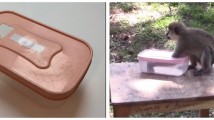We studied competitive interactions of rats during instrumental foraging behavior. Two groups of animals were revealed: rats with predominance of operant actions for getting food reinforcements (donors) and kleptoparasites that more often get food after instrumental acts of the partners. Intergroup differences began to appear and increased from 3-4 paired experiments. It was revealed that at the individual stage of learning the instrumental skill, donor rats were faster in learning and showed high foraging activity with shorter latency in comparison with kleptoparasites, which were initially slower and performed a large number of inter-signal actions in the form of unconditioned peeking into the feeder.
Similar content being viewed by others
References
Parfenov AI. Social relations of animals in the light of sociobiology. Izv. Saratov. Univ. Nov. Ser. Filosof. Psikhol. Pedagog. 2009;9(3):41-47. Russian.
Iyengar EV. Kleptoparasitic interactions throughout the animal kingdom and a re-evaluation, based on participant mobility, of the conditions promoting the evolution of kleptoparasitism. Biol. J. Linn. Soc. 2008;93(4):745-762. https://doi.org/10.1111/j.1095-8312.2008.00954.x
Hadjichrysanthou C, Broom M, Rychtář J. Models of kleptoparasitism on networks: the effect of population structure on food stealing behaviour. J. Math. Biol. 2018;76(6):1465-1488. https://doi.org/10.1007/s00285-017-1177-7
Vickery WL. Producing and scrounging can have stabilizing effects at multiple levels of organization. Ecol. Evol. 2020;10(6):2969-2978. https://doi.org/10.1002/ece3.6111
Alfaro L, Cabrera R. Effect of group size on producer-scrounger strategies of Wistar rats. Behav. Processes. 2021;182:104280. https://doi.org/10.1016/j.beproc.2020.104280
Sacramento TS, Bicca-Marques JC. Scrounging marmosets eat more when the finder’s share is low without changing their searching effort. Animal Behaviour. 2022;183:117-125. https://doi.org/10.1016/j.anbehav.2021.11.003
Lee AEG, Cowlishaw G. Switching spatial scale reveals dominance-dependent social foraging tactics in a wild primate. PeerJ. 2017;5:e3462. https://doi.org/10.7717/peerj.3462
Galef BG Jr, Marczinski CA, Murray KA, Whiskin EE. Food stealing by young Norway rats (Rattus norvegicus). J. Comp. Psychol. 2001;115(1):16-21. https://doi.org/10.1037/0735-7036.115.1.16
Phillips JA, Peacock SJ, Bateman A, Bartlett M, Lewis MA, Krkošek M. An asymmetric producer-scrounger game: body size and the social foraging behavior of coho salmon. Theor. Ecol. 2018;11(4):417-431. https://doi.org/10.1007/s12080-018-0375-2
Barou-Dagues M, Hall CL, Giraldeau L-A. Individual differences in learning ability are negatively linked to behavioural plasticity in a frequency-dependent game. Animal Behaviour. 2020;159:97-103. https://doi.org/10.1016/j.anbehav.2019.11.011
Vernouillet A. On the importance of accounting for alternative foraging tactics when assessing cognitive performance in wild animals. J. Anim. Ecol. 2021;90(11):2474-2477. https://doi.org/10.1111/1365-2656.13602
Garay J, Cressman R, Xu F, Broom M, Csiszár V, Móri TF. When optimal foragers meet in a game theoretical conflict: A model of kleptoparasitism. J. Theor. Biol. 2020;502:110306. https://doi.org/10.1016/j.jtbi.2020.110306
Geffroy B, Bolliet V, Bardonnet A. Kleptoparasitism and aggressiveness are influenced by standard metabolic rate in eels. Physiol. Behav. 2016;157:165-169. https://doi.org/10.1016/j.physbeh.2016.01.046
Murtazina EP, Buyanova (Matiulko) IS, Ginzburg-Shik YuA. Experimental models of the dyadic operant behavior of rats in different social contexts. Zool. Zh. 2021;100(5):540-548. Russian. https://doi.org/10.31857/S0044513421050093
Aplin LM, Morand-Ferron J. Stable producer-scrounger dynamics in wild birds: sociability and learning speed covary with scrounging behaviour. Proc. Biol. Sci. 2017; 284:20162872. https://doi.org/10.1098/rspb.2016.2872
Author information
Authors and Affiliations
Corresponding author
Additional information
Translated from Byulleten’ Eksperimental’noi Biologii i Meditsiny, Vol. 174, No. 11, pp. 541-546, November, 2022
Rights and permissions
Springer Nature or its licensor (e.g. a society or other partner) holds exclusive rights to this article under a publishing agreement with the author(s) or other rightsholder(s); author self-archiving of the accepted manuscript version of this article is solely governed by the terms of such publishing agreement and applicable law.
About this article
Cite this article
Murtazina, E.P., Ginsburg-Shik, Y.A. & Pertsov, S.S. Formation of Different Strategies of Competitive Foraging Behavior in Rats. Bull Exp Biol Med 174, 589–593 (2023). https://doi.org/10.1007/s10517-023-05752-y
Received:
Published:
Issue Date:
DOI: https://doi.org/10.1007/s10517-023-05752-y




